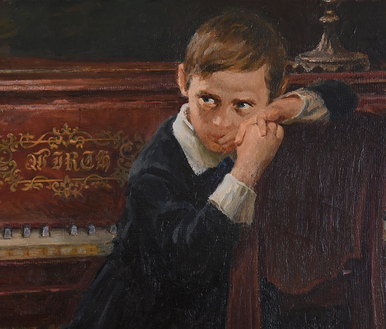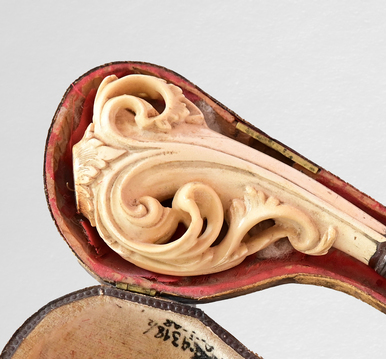This panel was acquired by the staff of the Museum Estate of P. I. Tchaikovsky in 1987 at the Moscow Commission shop No. 15 specifically for the exhibition of the memorial estate.
It is an embroidered panel with small colored beads on a fabric canvas. It depicts half of a wreath with a pink rose in the center. To the left and to the right of it are blue and light blue Ipomoea flowers. A red poppy, a blue-orange inflorescence of auricula and a small lilac sprig are embroidered to the left. The flower arrangement on the right is continued with an orange marigold flower and ends with a branch of flowering rose hips.
Two yellow flowers with a red core are sewn along the lower corners of the panel, embroidered with satin stitch. The embroidery is displayed in a wooden frame, which is decorated with brass overlays at the corners and along the perimeter.
At the beginning of the 19th century, beadwork was one of the most popular hobbies of young women and girls. Young ladies embroidered screens for fireplaces, wallets, pouches, handbags and even collars for lapdogs. It was also fashionable to embroider furniture items to decorate the interior. Embroidered beaded panels were inserted into needlework boxes, work tables, ladies’ bureaus and bookshelves. Napkins were woven from beads and used as coasters for lamps and vases. Embroidered items were intended primarily for decorating ladies’ studies or boudoirs. Drawings for beaded needlework were mainly created by professional artists who made them themselves or used paintings, prints, book illustrations, and vignettes as models.
Working with beads required patience. In order to cultivate this quality, in the past girls had the so-called lessons of patience. A girl was given tangled threads, and had to untangle them and roll them in a neat ball without breaking. In the Tchaikovsky family, the girls were taught needlework by the elder relatives of the composer’s father Ilya, his sister Nastasya Popova and aunt Nadezhda Valtseva. The composer’s mother, Alexandra Andreyevna, was also quite skillful at embroidery. In a letter dated from March 31, 1837, Ilya Petrovich wrote to his wife, ‘Have you forgotten, my soul, that you promised me to embroider a chibouk? ’
It is an embroidered panel with small colored beads on a fabric canvas. It depicts half of a wreath with a pink rose in the center. To the left and to the right of it are blue and light blue Ipomoea flowers. A red poppy, a blue-orange inflorescence of auricula and a small lilac sprig are embroidered to the left. The flower arrangement on the right is continued with an orange marigold flower and ends with a branch of flowering rose hips.
Two yellow flowers with a red core are sewn along the lower corners of the panel, embroidered with satin stitch. The embroidery is displayed in a wooden frame, which is decorated with brass overlays at the corners and along the perimeter.
At the beginning of the 19th century, beadwork was one of the most popular hobbies of young women and girls. Young ladies embroidered screens for fireplaces, wallets, pouches, handbags and even collars for lapdogs. It was also fashionable to embroider furniture items to decorate the interior. Embroidered beaded panels were inserted into needlework boxes, work tables, ladies’ bureaus and bookshelves. Napkins were woven from beads and used as coasters for lamps and vases. Embroidered items were intended primarily for decorating ladies’ studies or boudoirs. Drawings for beaded needlework were mainly created by professional artists who made them themselves or used paintings, prints, book illustrations, and vignettes as models.
Working with beads required patience. In order to cultivate this quality, in the past girls had the so-called lessons of patience. A girl was given tangled threads, and had to untangle them and roll them in a neat ball without breaking. In the Tchaikovsky family, the girls were taught needlework by the elder relatives of the composer’s father Ilya, his sister Nastasya Popova and aunt Nadezhda Valtseva. The composer’s mother, Alexandra Andreyevna, was also quite skillful at embroidery. In a letter dated from March 31, 1837, Ilya Petrovich wrote to his wife, ‘Have you forgotten, my soul, that you promised me to embroider a chibouk? ’

